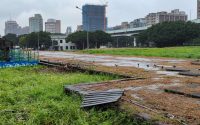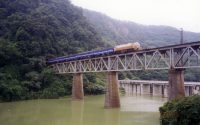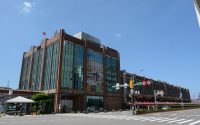搶救!高雄客運岡山舊站
Saving Old Gangshan Terminal of Kaohsiung Bus
文:陳敬恆(Chen, Jingheng)
攝影:陳敬恆、古庭維(Ku, Tingwei)
建於1963年,大高雄現存最古老的公路客運建築*--高雄客運岡山站,於3月28日面臨拆除危機。身為同輩中碩果僅存者,岡山站不僅用自身的興衰見證了岡山市鎮的變遷,更用它的形式、設計,記憶著上個世代的客運營業型態和行旅日常。如今雖因暫定古蹟得以暫緩動工,然危機並未解除,仍亟待各界出手相救。
Built in 1963, Old Gangshan (岡山) Terminal of Kaohsiung Bus is the oldest[1]among all existing bus terminal buildings in Greater Kaohsiung Area. Unfortunately, it has faced the danger of being torn down since March 28th, 2018. Gangshan Terminal, among all its peers, bears special meaning in two aspects. Its rise and fall corresponds to the evolution of Gangshan Town Center. Its architectural structure and design commemorates the operation style and traveling experiences of inter-city bus in the past generation. Currently it is designated as interim monument and the demolishment is postponed. However, the crisis never leaves. Gangshan Terminal still await rescue from all the concerning groups and individuals.
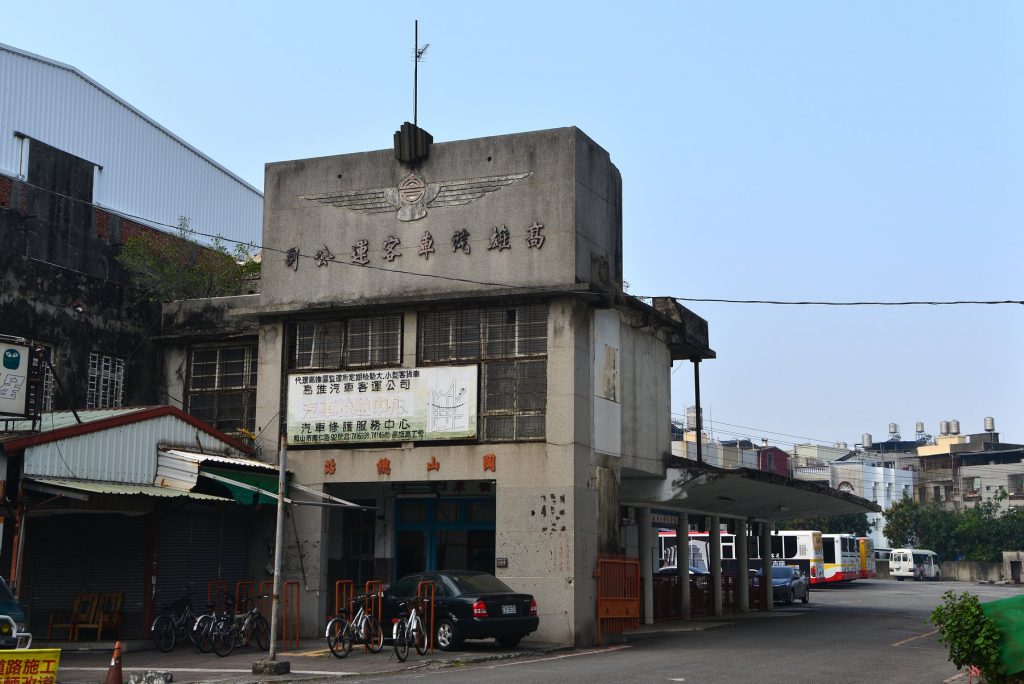
The main building of Kaohsiung Bus Old Gangshan Terminal has seen almost 55 years.
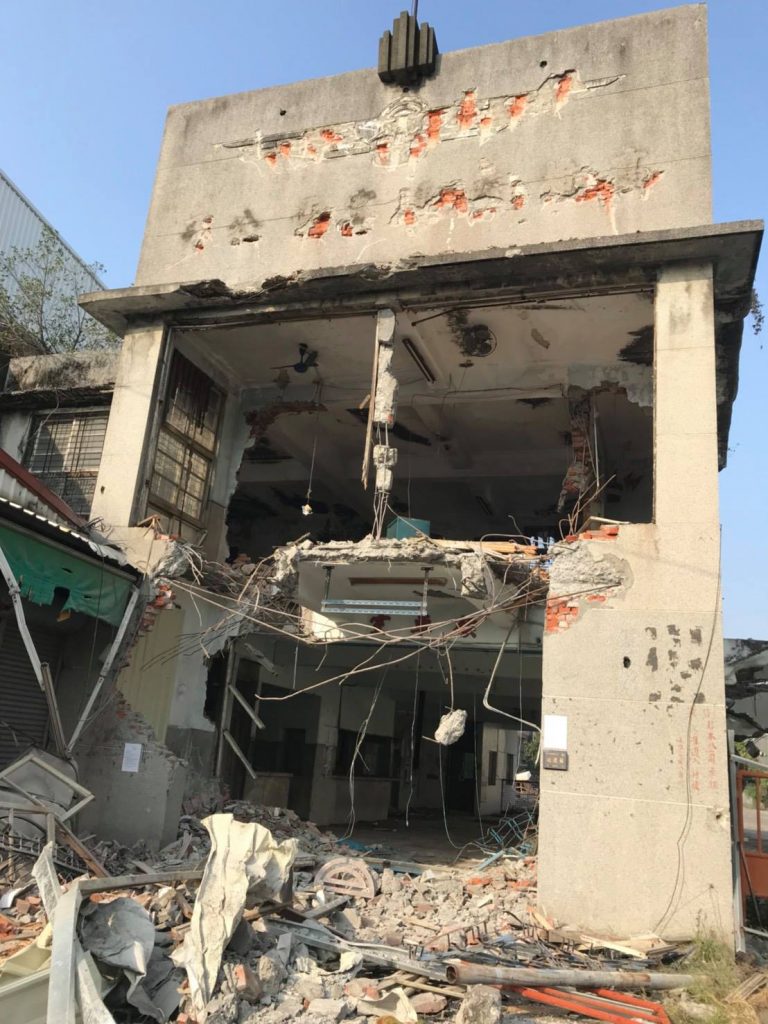
The scar of the building is such a shock! Luckily the demolishment has been postponed and things are still negotiable.
高客岡山站位於舊市區邊緣,隨著1993年臺鐵改線完工、第三代(現今)岡山站啟用,而逐漸遠離轉運中心。2008年高雄捷運紅線通車,後續八、九年間公車路網次第重整,過去優勢的位置竟成路線圖上必須刻意繞抵的末梢,曾經繁忙的候車室日益空曠。2017年中,站場正式遷至橋頭筆秀地區(鄰近捷運南岡山站)停車場,原址遂告廢棄。
Located on the edge of old central Gangshan, the terminal has become farther and farther from the hub of transportation network since the 1993 rerouting of TRA line and the inauguration of 3rdgeneration Gangshan Railway Station at the same time. Following that are the opening of Kaohsiung Metro Red Line in 2008, and the reform of bus network since then. The once superior location now becomes a burden, an odd position that takes a detour to reach. Past hustle and bustle are gone, leaving the spacious waiting room emptier and emptier. In the middle of 2017, the title Gangshan Terminal shifted its location from the old terminal building to the parking spaces in Bixiu (筆秀), Qiaotou (橋頭),near the Kaohsiung Metro Gangshan South Station. That was when the old building was officially abandoned.
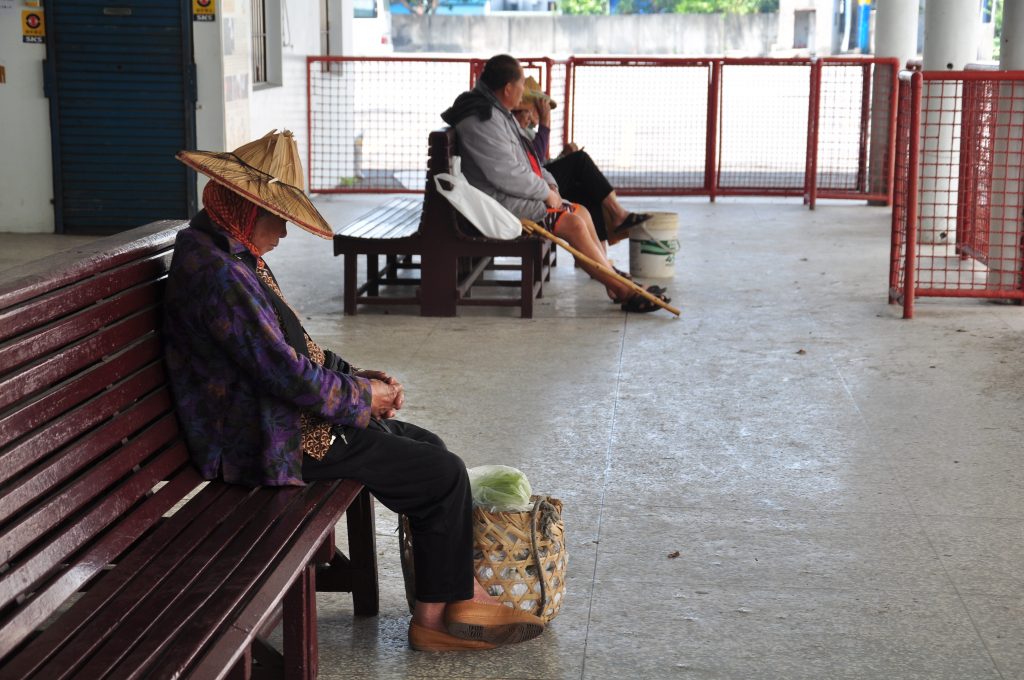
Bus terminal bears the memory of local people.
保留一個客運站,就是保留一個城鎮的發展軌跡。
To save a bus terminal is to preserve the trajectory of a town’s development.
建築本身屬於臺灣戰後初期的現代主義風格,簡潔沉穩的造型由方正的兩層樓房,和絲毫不顯笨重的混凝土上挑雨庇構成,分別擔當辦公空間以及旅客候車室兼乘車月台。外牆飾以洗石子,搭配立面上浮凸的高雄客運商標及站名字樣;內部天花板上的Art Deco花紋,以及二樓對陽台的外推雙扇八角窗,則是機能之外的小小驚喜。
The architecture itself, on the other hand, represents the Modernism style in Taiwan after World War II. The terminal building comprises two parts. The box-shaped two-storied office building stands in the front; the canopy that curves upward at the ends covers the waiting space and platform in the rear, which serve the staff and the passengers, respectively. Though concrete-made, the shape of the canopy makes it look lightweight. The walls are covered with pebble wash finish, along with the logo of Kaohsiung Bus Company and the terminal’s name on the façade. The ceiling inside is embellished with Art Deco styled pattern. These decorations, together with the dual-sash, pushing-out, octagon window between the office and balcony on the second floor, are small surprises beyond the building’s function.
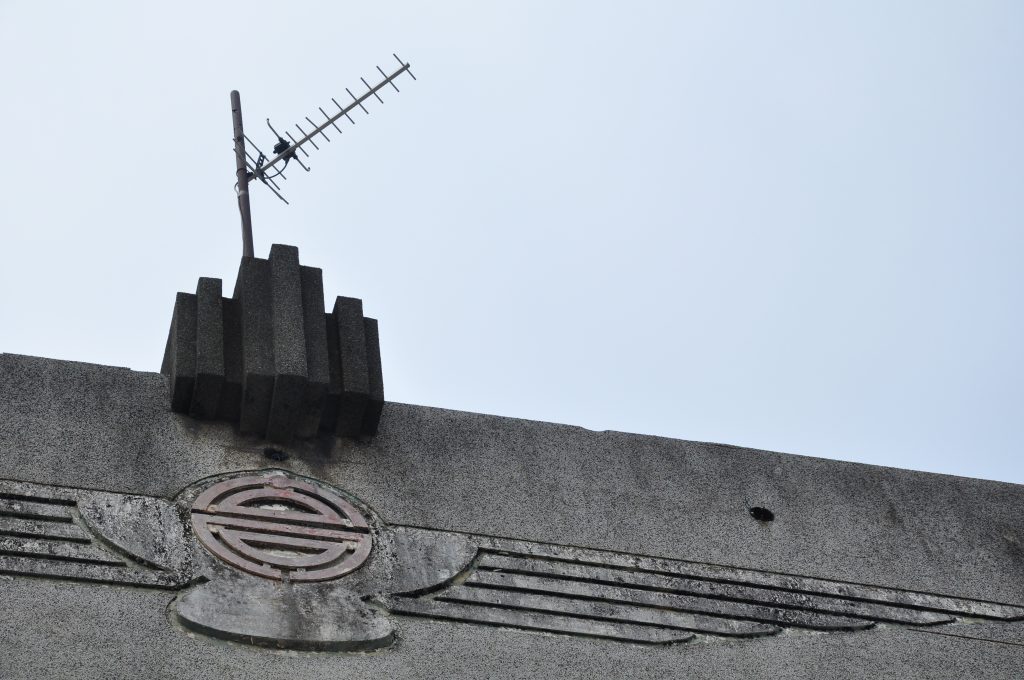
On the façade are the embossing logo of Kaohsiung Bus and the shield-shaped decoration.
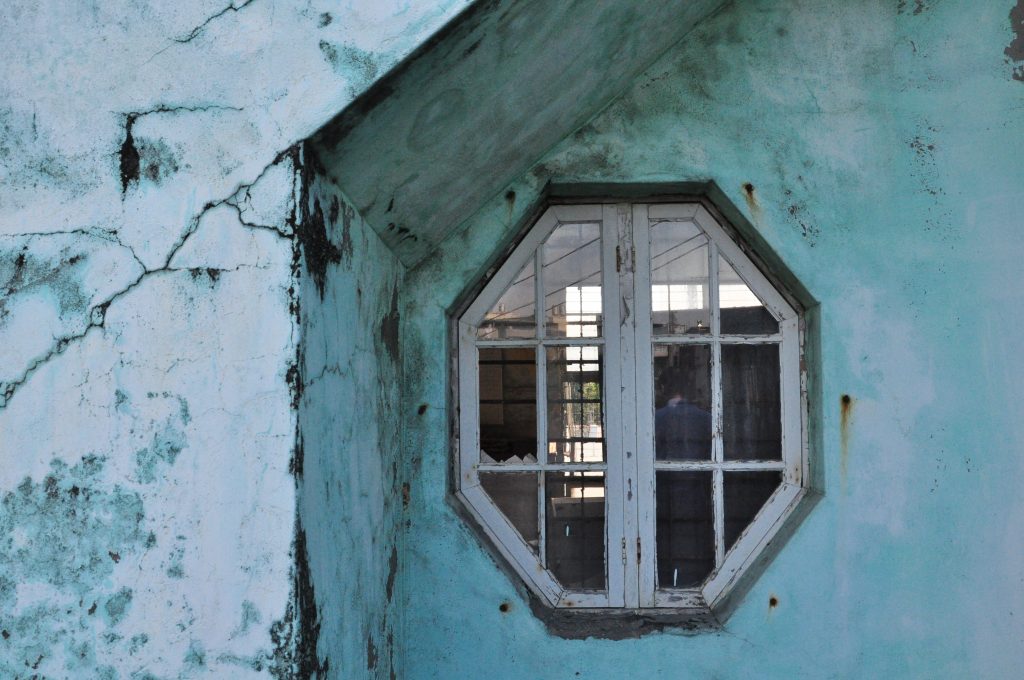
The octagon window on the second floor is dual-sashed, with its hinges in the middle.
穿過由古樸木門分隔的玄關,候車室隨處可見過去營業方式的陳跡。窗口共二處,隔間牆上的售票窗口停止服務後已被時刻看板遮蔽,反映客運收費方式的演變。另一窗口推測為服務台,圓弧形磨石子台面框起巧妙內縮的空間,維持候車室的方正寬敞。二者均妥善嵌合於建築的原始設計中,凸顯形式追隨機能的特色。其餘如鋸齒狀月台、目的地燈箱,在在顯示過去客運站除營運功能外,更深具旅客服務意義。
Walking through the antique wooden door, from the foyer to the waiting room, one can see the traces of past operation style. There are two windows between the space for staff and the space for passenger. The ticket window on the partition has been covered by a schedule board since it ceased usage. This reflects the change in fare collection of inter-city bus. The other window is the information desk with curved terrazzo desktop circling the ingeneously receding space. This design keeps the waiting room a complete, broad square. The two windows are well embedded in the building’s original design, stating “form follows function”. Other objects, such as the zig-zag platform, the destination lightbox, all demonstrate that the bus terminal in the past provided a variety of services to passengers, rather than simply operated buses.
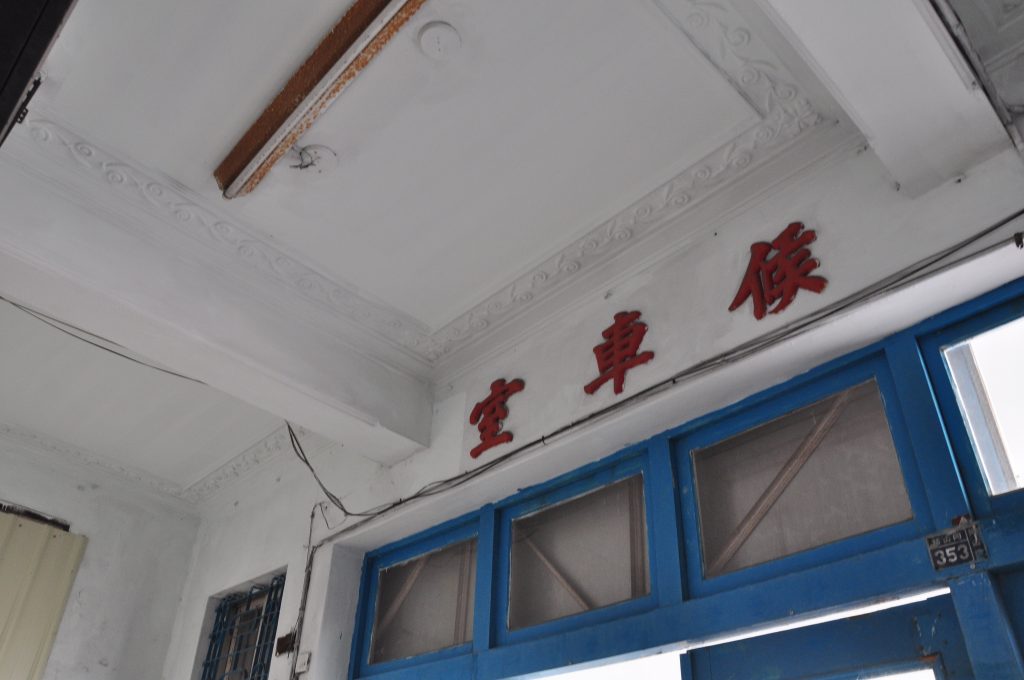
The blue wooden door and the characters for “waiting room” give whoever stepping in this building their first impression.
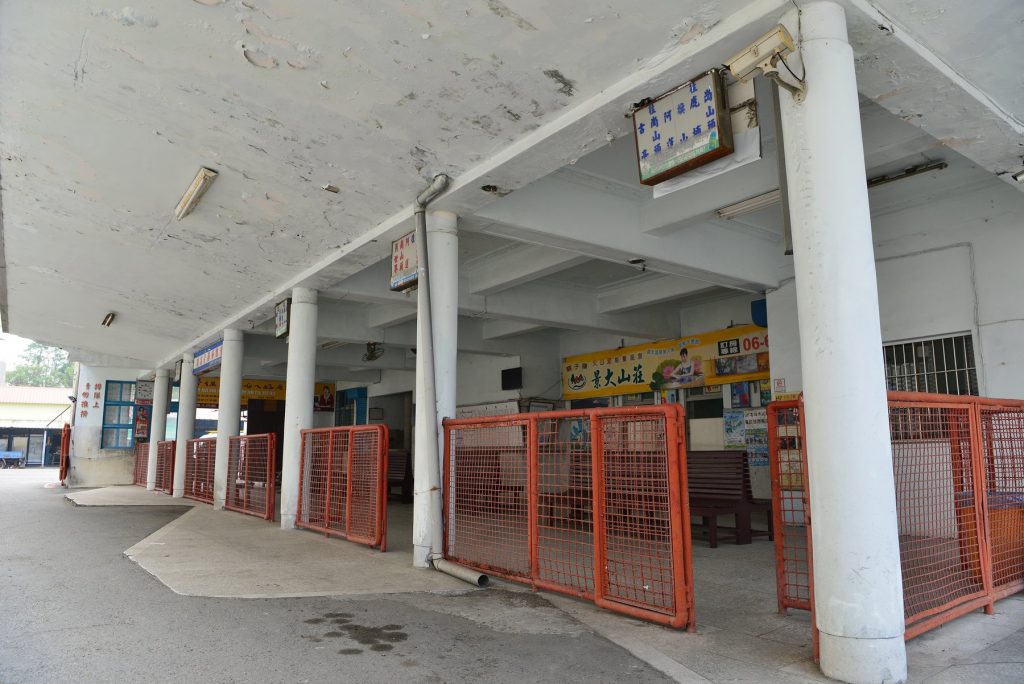
Zigzag design of platform edge caters the dwelling buses.
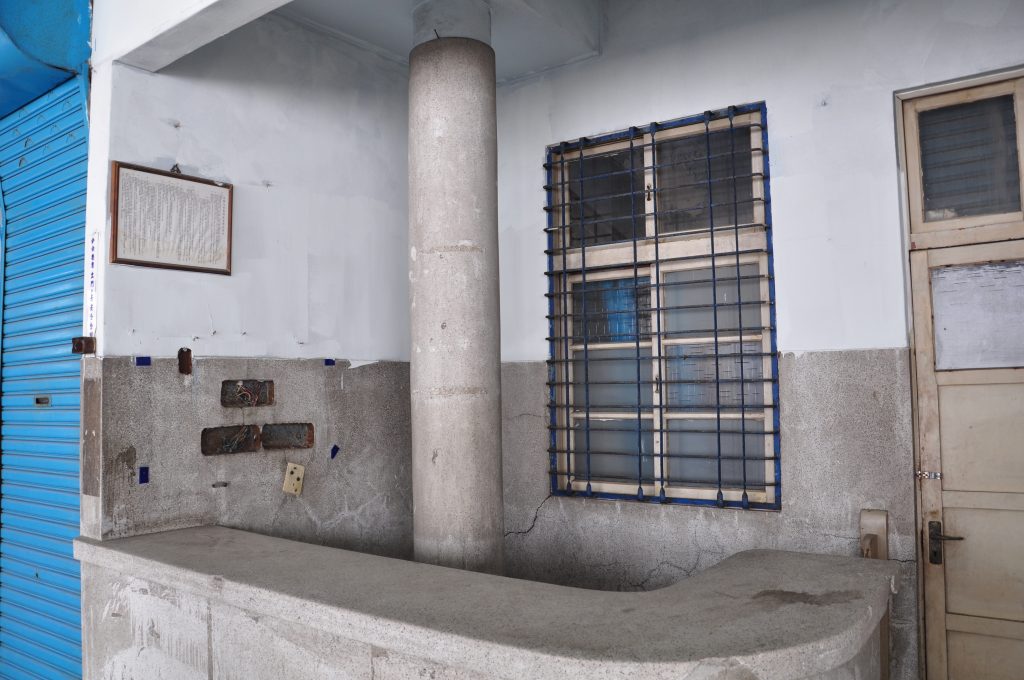
The information desk is ingeniously embedded in the original design of the building.
保留一個岡山站,更可以保留一個世代的客運站風格。
To save one Gangshan Terminal is to save the style of a generation’s bus terminals.
如今,岡山站立面遭到破壞,前途未卜。期待政府除了貼上一紙暫定古蹟公告,能有其他積極作為。更迫切希望透過關心的人將消息傳遞出去,搶救這個未受重視的公路文化資產。岡山舊火車站已不幸焚毀,莫讓遺憾在此重演!
Now, the façade of Gangshan terminal has been destroyed. The entire building is still lingering between life and death. We urge the government be more active, besides just posting a piece ofi nterim monument announcement. It is even more urgent that anybody who cares about this issue should pass the message forward. It has been too long that cultural heritages related to highway tranportation are overlooked. The old Gangshan Railway Station was burned down. Let there be no such story again.
*註:同屬高雄客運的六龜站雖年代更久,且具文資身分,但其原始用途為旅館,形制上並不屬於客運站建築。
[1] The Liugui (六龜) Terminal of Kaohsiung Bus is older in age, and is designated as a historic building. However, the building was originally built as a hotel, not in the form of a bus terminal.

